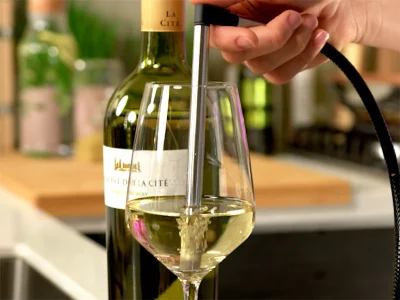Aeration is a technique that is often associated with red wine, but did you know that white wine can also benefit from this process? So, the question that most people still search around is, do you aerate white wine, and is it the best thing to do?
White wine can benefit from aeration, as it allows the wine to open up and release its full flavors and aromas. Aeration can be done by simply letting the wine sit in the open air for a period of time or by using a decanter or aerator to actively expose the wine to oxygen. Different types of white wine may benefit from different levels of aeration.
Generally, fuller-bodied white wines such as Chardonnay can benefit from more aeration, while lighter-bodied wines such as Riesling may not need as much. Ultimately, the decision to aerate white wine is a matter of personal preference and can be determined through experimentation and tasting.
What is wine aeration and why is it important for white wine?
Wine aeration is the process of exposing wine to oxygen in order to enhance its flavors and aromas. It is often done by pouring the wine into a decanter or using an aerator, which can be a simple device that fits onto the bottle’s spout. The oxygen helps to release the wine’s aromas and flavors, which can make it taste smoother and more complex.
For white wine, aeration can be particularly important because white wines tend to be bottled young and may not have had as much time to age and develop as red wines. Aeration can help to bring out the full potential of the wine, allowing the drinker to fully appreciate its complexity and depth. Additionally, aeration can also help to soften harsh flavors in the wine, making it more drinkable.
It is worth noting that not all white wines need to be aerated, and the decision to aerate is a matter of personal preference. Experimentation and testing can help determine whether or not a particular white wine benefits from aeration.
How to aerate white wine: a step-by-step guide
Aerating white wine can enhance its flavors and aromas, making for a more enjoyable and elevated wine-drinking experience. Here is a step-by-step guide on how to aerate white wine:
- Select the right bottle of white wine. Fuller-bodied white wines such as Chardonnay and Viognier tend to benefit more from aeration than lighter-bodied wines such as Riesling or Sauvignon Blanc.
- Open the bottle of white wine and pour a glass. Take note of the wine’s initial aroma and flavor.
- Decant the wine: Carefully pour the remaining wine into a decanter. This process exposes the wine to more oxygen, which helps to release the wine’s aromas and flavors.
- Allow the wine to aerate: Let the wine sit in the decanter for at least 20 minutes before serving. The longer you allow the wine to sit, the more it will aerate.
- Taste the wine again after aeration: Compare the aroma and flavor to the initial glass that you poured. You should notice a difference in the wine’s complexity and smoothness.
- Serve the wine: Once the wine has been aerated to your liking, pour it into glasses and enjoy it.
Alternatively, if you do not have a decanter, you can use an aerator, which can be a simple device that fits onto the bottle’s spout and help aerate the wine as you pour it into a glass.
It’s worth noting that not all wines need to be aerated, and the decision to aerate is a matter of personal preference. Experimentation and testing can help determine whether or not a particular white wine benefits from aeration.
Do you have to aerate all white wines or just certain types?
Not all white wines need to be aerated. The decision to aerate is a matter of personal preference and can depend on the type of white wine you are drinking.
Generally, fuller-bodied white wines such as Chardonnay and Viognier tend to benefit more from aeration than lighter-bodied wines such as Riesling or Sauvignon Blanc. These types of white wines have more complex flavors and aromas that can be released by aeration, making them taste smoother and more balanced.
On the other hand, lighter-bodied white wines such as Riesling or Sauvignon Blanc often have more delicate flavors and aromas that can be overpowered by aeration. These types of wines may not need as much aeration or may not benefit from it at all.
Ultimately, the best way to determine whether or not a particular white wine benefit from aeration is through experimentation and tasting. You can try aerating a small amount of the wine and taste the difference to see if it improves the flavor and aroma to your liking.
The difference between aerating white wine and decanting red wine
Aerating and decanting are two techniques used to enhance the flavor and aroma of the wine.
Aerating white wine involves exposing the wine to oxygen to release its full flavors and aromas. It is often done by pouring the wine into a decanter or using an aerator, which can be a simple device that fits onto the bottle’s spout. Aeration can be particularly important for white wines as they tend to be bottled young and may not have had as much time to age and develop as red wines.
Decanting red wine, on the other hand, is the process of pouring the wine into a decanter to separate the wine from the sediment that has settled at the bottom of the bottle. Decanting can also help to expose the wine to oxygen, which can enhance its flavors and aromas. Additionally, decanting can also help to soften the tannins, making the wine taste smoother and more balanced.
Both aerating and decanting can help to improve the taste and aroma of wine, but the process and purpose are different. Aerating is mainly for white wine to bring out its full potential, whereas decanting is for red wine to separate the wine from the sediment and also expose it to oxygen to bring out its flavors and aromas.
How long should you aerate white wine before drinking it?
The length of time that you should aerate white wine before drinking it can depend on the type of white wine and your personal preference.
For most white wines, aerating for 20-30 minutes can be sufficient to release the wine’s full flavors and aromas. However, some fuller-bodied white wines, such as Chardonnay, may benefit from longer aeration times of up to an hour or more.
If you’re not sure how long it takes to aerate your white wine, start with a shorter time period (20-30 minutes) and taste the wine. If you feel that the wine could use more aeration, you can let it sit for longer. It is also recommended to taste the wine along the way, so you can determine when the wine reaches your desired level of aeration.
It’s worth noting that not all wines need to be aerated, and the decision to aerate is a matter of personal preference. Experimentation and testing can help determine whether or not a particular white wine benefits from aeration and for how long.
Best tools for aerating white wine at home
There are several tools that can be used to aerate white wine at home, each with its own unique benefits.
Some of the best tools for aerating white wine include:
- Decanter: A decanter is a large glass or crystal container that is used to hold and serve wine. Decanting wine exposes it to oxygen, which can help to release its flavors and aromas. A decanter can be particularly useful for fuller-bodied white wines such as Chardonnay that benefit from longer aeration times.
- Wine Aerator: A wine aerator is a device that fits onto the bottle’s spout and helps to aerate the wine as you pour it into a glass. It works by forcing the wine through a small chamber, which causes it to mix with air and release its aromas and flavors. Wine aerators are convenient and easy to use, making them a great option for those who want to aerate their wine quickly.
- Wine Pourer: A wine pourer is a small device that fits onto the bottle’s spout and controls the flow of wine as it is poured. They can also help to aerate the wine slightly as it flows through the spout.
- Wine Glasses: Certain wine glasses are specifically designed to enhance the flavors and aromas of the wine. A wine glass with a larger bowl and a smaller opening at the top, for example, can help to aerate the wine as it is poured, allowing the wine to breathe and release its full potential.
- Whipping siphon: A whipping siphon is a tool that is used to aerate liquids by whipping in the air. It can be used to aerate white wine by whipping air into the wine, creating small bubbles that can help release the wine’s aroma and flavors.
Ultimately, the best tool for aerating white wine at home will depend on your personal preference and the type of white wine you are drinking. Experimentation and tasting can help you determine which tool works best for your needs.
How does aeration affect the flavor and aroma of white wine?
Aeration, or the exposure of wine to air, can affect the flavor and aroma of white wine in several ways.
When white wine is first poured, it may be closed and tight, with little aroma and flavor. This is due to the fact that wine contains volatile compounds that are responsible for its aroma and flavor. When these compounds come into contact with oxygen, they begin to break down and release their aromas and flavors.
Aeration can help to speed up this process and release the wine’s aromas and flavors more quickly. This can make the wine taste more complex and can enhance the perception of certain aromas and flavors, such as fruit and floral notes.
Additionally, aeration can also help to soften the acidity in white wine and make it taste smoother and more balanced. This is because the acidity in wine is due to the presence of volatile acidity, which can be reduced by aeration. When volatile acidity is reduced, the wine will taste less acidic and more rounded.
However, it is important to note that some white wines are more delicate and may lose their aroma and flavor if they are aerated too much. Such wines are usually wines with low alcohol and high acidity, which get oxidized easily; therefore, it is important to aerate them for a short period of time.
Overall, Aeration can greatly affect the flavor and aroma of white wine, but it is important to be mindful of the type of white wine and the duration of aeration, as over-aeration can have a negative impact on the taste.
Can you aerate white wine too much?
Yes, it is possible to aerate white wine too much. Aeration is the process of exposing the wine to air, which can help to release its aromas and flavors.
However, if white wine is aerated for too long or exposed to too much air, it can cause the wine to oxidize, which can lead to a loss of aroma and flavor. Additionally, over-aeration can also cause the wine to become too soft and lose its acidity, making it taste flabby and unbalanced.
Wines that are more delicate and have a low alcohol content and high acidity are more prone to oxidation; therefore, they should be aerated for a short period of time.
Moreover, some white wines, such as Riesling, Sauvignon Blanc, and Chenin Blanc, are more delicate and should be aerated for shorter periods of time, while others, such as Chardonnay, Viognier, and Marsanne, can handle more aeration and can be decanted for a longer period of time before serving.
How to aerate white wine without a decanter or aerator
There are several ways to aerate white wine without using a decanter or aerator. Some methods include:
- Pouring the wine back and forth between two glasses: This method involves pouring the wine back and forth between two glasses multiple times. This creates a lot of movement and agitation, which can help to release the wine’s aromas and flavors.
- Swirling the wine in the glass: This method involves holding the glass by the stem and swirling the wine around in the glass. This helps to release the wine’s aromas and flavors.
- Using a straw: This method involves sticking a straw into the bottle and blowing air into the wine. This can help to release the wine’s aromas and flavors.
- Using a whisk or a fork: This method involves using a whisk or a fork to agitate the wine in the bottle. This can help to release the wine’s aromas and flavors.
- Opening the bottle and letting it sit: This method involves simply opening the bottle and letting it sit for a period of time before serving. The longer the wine sits open, the more time it has to aerate and release its aromas and flavors.
It’s worth noting that all the methods listed above are alternatives to decanting and aerating white wine, But the level of aeration is not as much as using a decanter or aerator. Also, it’s better to aerate the wine for a shorter period of time to avoid oxidation and loss of flavors and aroma.
The impact of aging on white wine aeration
Aging can have an impact on white wine aeration. As white wine ages, it can become more complex and nuanced in flavor and aroma, but it also becomes more delicate.
Young white wines are usually high in acidity and have fresh, fruity flavors and aromas. They can be aerated for a short period of time to release their aromas and flavors. As white wines age, they can lose some of their acidity and freshness, becoming smoother and more rounded. Aeration can help to release the aging wine’s complex aromas and flavors, making it taste more balanced.
However, older white wines can be more delicate and may lose their aroma and flavor if they are aerated too much. The aging process also causes some of the volatile compounds to evaporate, which are responsible for aroma and flavor. Over-aeration can speed up this process, causing the wine to lose its aroma and flavor more quickly.
Therefore, when aerating aged white wines, it is important to be mindful of the duration of aeration, as over-aeration can have a negative impact on the taste. Also, it’s better to taste the wine first and decide how much aeration it needs, and it may not need any aeration at all.
How does temperature affect white wine aeration?
Temperature can affect white wine aeration in several ways.
- Cold wine: Serving white wine that is too cold can mask its aroma and flavor. As the wine warms up, it will release its aromas and flavors, which can make it taste more complex and enjoyable. Aeration can help to speed up this process by exposing the wine to air, which can help to release its aromas and flavors more quickly.
- Room temperature wine: Serving white wine at room temperature is ideal for most white wines as it allows the wine to fully express its aroma and flavor. Aeration can enhance the wine’s aroma and flavor by exposing it to air.
- Warm wine: Serving white wine that is too warm can cause the wine to oxidize, which can lead to a loss of aroma and flavor. Additionally, warm wine can also cause wine to taste flabby and unbalanced. Aeration can help to mitigate some of the negative effects of warm wine by exposing it to air, but it is not a substitute for proper temperature storage and service.
Generally, the temperature can affect white wine aeration. Serving white wine at the appropriate temperature can help to enhance its aroma and flavor while serving it too cold or too warm can mask its aroma and flavor. Aeration can help to speed up the process of releasing the wine’s aroma and flavor, but it is not a substitute for proper temperature storage and service.
Recommended:
How to properly store white wine after aeration
Properly storing white wine after aeration can help to preserve its flavor and aroma.
- Keep the wine in a cool, dark place: White wine should be stored at a temperature between 45-55 °F (7-13 °C) and away from light, as light can cause the wine to spoil. If possible, store the wine in a wine refrigerator or a wine cellar.
- Keep the wine in an upright position: White wine should be stored in an upright position, as this prevents the cork from drying out and allowing air into the bottle, which can cause the wine to spoil.
- Keep the wine sealed: Once the wine has been aerated, it should be sealed with a cork or screw cap to prevent air from entering the bottle.
- Consume the wine within a reasonable time frame: White wine should be consumed within a reasonable time frame, as it can spoil if it is stored for too long. The time frame will vary depending on the type of white wine and the storage conditions.
- Keep the wine at the right level: White wines should be kept at the right level, as it will help to keep the cork from drying out and also prevent the wine from being exposed to air.
It’s worth noting that aerated white wine will lose its freshness and aroma faster than un-aerated white wine; therefore, it should be consumed shortly after aeration.
In conclusion, properly storing white wine after aeration can help to preserve its flavor and aroma. White wine should be stored in a cool, dark place, in an upright position, sealed, consumed within a reasonable time frame, and kept at the right level.
Conclusion
This page gives the answers to the question do you aerate white wine. Aerating white wine can enhance its flavor and aroma by exposing it to air. Aeration can help to release the wine’s aromas and flavors more quickly, make the wine taste more complex and enjoyable, and soften the acidity in white wine and make it taste smoother and more balanced.
However, it is important to be mindful of the type of white wine and the duration of aeration, as over-aeration can have a negative impact on the taste. Some white wines, such as Riesling, Sauvignon Blanc, and Chenin Blanc, are more delicate and should be aerated for shorter periods of time, while others, such as Chardonnay, Viognier, and Marsanne, can handle more aeration.




